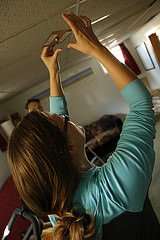Fungi thrived in flooded Colorado homes months after waters receded

Basements that flooded after heavy rains deluged the Colorado Front Range in September 2013 had higher levels of airborne mold and other fungi months after the waters receded compared with basements that didn't flood, according to a study by the University of Colorado Boulder.
The researchers found about twice as much fungal DNA in flooded homes than in non-flooded homes, despite the fact that most of the flooded basements they sampled had already been remediated, a process which often includes throwing out old furniture, replacing drywall and flooring, and treating dried surfaces with chemicals that deter microbial growth.
The findings, published in the journal Environmental Science & Technology and funded by the Alfred P. Sloan Foundation, also show that the types of fungi—and airborne bacteria—found in flooded homes were different than those in non-flooded homes.
"It was surprising to find that months after the flood had happened, and homes had for the most part been remediated, the microbial ecology in the flooded homes was still very different compared to the non-flooded homes," said Shelly Miller, an associate professor of mechanical engineering and co-author of the paper. "It suggests that returning a home to its state before a flood will take a longer time, or a different remediation approach than was typically used in the homes we studied."
Miller and the other study authors, including CU-Boulder microbiologist Noah Fierer, were also surprised that the differences in the bacteria and fungi found indoors were detected even though the humidity registered the same in both flooded and non-flooded basements by the time the samples were taken.
Fierer, an associate professor in the Department of Ecology and Evolutionary Biology and a fellow at the Cooperative Institute for Research in Environmental Sciences, was inspired to do the study while walking through his south Boulder neighborhood after the September floods, which occurred after 15 inches of rain fell in parts of the city. Many of the basements that flooded in Boulder did so because of rising groundwater levels, not because of creeks overtopping their banks, which meant that each property's drainage and geography affected whether that particular house was affected.
"The Boulder flood was very patchy," Fierer said. "I was walking down our street and half the homes had basement flooding and half didn't."
This gave the researchers a unique opportunity to compare flooded and non-flooded homes in the same area at the same time. Other studies of changes in fungi and bacteria in flooded homes have compared indoor air with nearby outdoor air or simply tracked changes to indoor air quality over time.
For the new study, the researchers sampled the air in 36 flooded and 14 non-flooded basements in south Boulder for a month and then compared the results.
The new study is also an improvement over many past studies in that it uses a relatively new DNA sequencing technique to determine the types and abundance of microbes found in the air. This technique allows for much more accurate results compared with older methods, which relied on culturing samples and seeing what grew. Scientists now know that as much as 99 percent of microorganisms are difficult to culture and, therefore, wouldn't be counted using such a method.
The diversity of bacteria and fungi identified using the DNA-based approach illustrate that there is a huge diversity of microbes that live with us in our homes—whether flooded or not—according to Fierer.
"People don't want to think about that, but it's true," Fierer said. "And it's not necessarily a bad thing. These aren't necessarily pathogens or allergens."
Some of the fungi found at increased levels in homes that had flooded are known allergens, Fierer said, but even so, it's not necessarily cause for alarm. Because Colorado is such a dry place, it's possible that the levels of fungi are still below what you might find in wetter regions of the country, for example.
While more research is needed in that area, the authors say it's important to begin looking at airborne bacteria and fungi as a component of air quality, a measure that has typically only included chemicals and particulate matter.
More information: "Impacts of Flood Damage on Airborne Bacteria and Fungi in Homes after the 2013 Colorado Front Range Flood" Environ. Sci. Technol., 2015, 49 (5), pp 2675–2684 DOI: 10.1021/es503845j
Journal information: Environmental Science & Technology
Provided by University of Colorado at Boulder


















